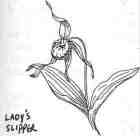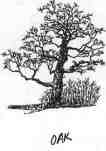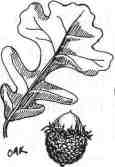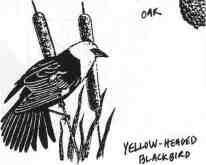The Woods of, the Future: A Project Log
May 17,1999
Received a call from John Citizen today asking what the park district's plan is for the property behind the softball fields—the place we've always referred to as "The Woods." I had to admit that we didn't have any real plans for those 15 acres and that aside from storing wood chips on the perimeter, I didn't know the site very well.
John said that it was an "ecologically significant" area and contained several endangered and threatened plant species. I've always enjoyed the outdoors, but I wouldn't know an endangered species if I stepped on it. John volunteered to walk the grounds with me. This must fall under "other duties as assigned" in my job description, but I agreed to meet him anyway.

May 23,1999
Just returned from The Woods. Incredible place! I can't believe that I've worked here for eight years and never bothered to check it out. Never noticed the big, old oak trees. Never heard the frogs singing in the wetland. Heck, I never even knew there was a wetland!
We spent two hours exploring the place. I felt like a kid on a field trip! There's an amazing variety of what John refers to as "native" plants in The Woods—plants that originally are from this part of the state and have existed here for thousands of years. In the openings under the ancient oaks, there were carpets of colorful flowers. I remember the name of one in particular—a white flower with three petals and leaves. White Trillium, I think. John said it's increasingly rare to find this one because it's a favorite with the deer.
According to John, The Woods is misnamed. He explained that the site is a combination of three communities: savanna (grassland with scattered oaks), wetland and prairie. It was in the prairie that we found the endangered Small White Lady's Slipper, an exquisite little orchid. It only grows in a few locations in the county. My favorite find, though, was the orange Hoary Puccoon. What a name!
June 24,1999
What to do with The Woods? I never gave it much thought before. Now I find I'm spending my lunch break there at least once a week. Even bought a wildflower field guide! John and a group of concerned citizens would like to see the place managed as a natural area and "restored to good ecological health and diversity," as he put it. Is this the role of a park district? I found my answer in a dusty copy of the Illinois Park and Recreation Association (IPRA) Model Environmental Policy. One of the six goals of the policy is Open Space
Planning and Preservation: Protect and restore indigenous natural communities such as grasslands, woodlands and wetlands.....If I remember correctly, our park board adopted this Environmental Policy three years ago.
June 25,1999
Spent the day on the phone with supervisors of
November/December 1997 / 33
SPECIAL FOCUS
|
|
|
nearby park and forest preserve districts. Most have one or more natural areas of varying acreage that they actively manage. It seems that more and more public agencies like ours are taking this route. As one supervisor said, "If we don't take responsibility for managing the remaining natural areas in our communities, who will?" Good question.
July 19,1999
After reviewing my proposal, our director gave the OK to hire an environmental consultant to study The Woods. Katie, an expert in the restoration of natural areas, has done projects for a half dozen other park districts. Her analysis of the site will include a survey of current conditions—soils, hydrology, plants and animals, and surrounding land uses—as well as a review of historical records.
This morning I had just identified an orange milkweed in the prairie as Butterfly Weed when I noticed some movement at the edge of the savanna. "Whose dog is that?" I wondered, then realized it wasn't a dog at all, but a coyote! This place is full of surprises!
August 3,1999
Katie has unearthed some amazing records— survey notes from the 1830s which document the types of trees and features of the landscape along the original township lines. The notes describe the area around The Woods as a long grove of oaks and other trees surrounded by prairies, some wet. The Woods is all that remains in our community of that grove and the prairies—the last vestige of our natural heritage.
September 11, 1999
Based on Katie's research, we've taken the next step and developed a complete management plan for The Woods. Katie recommends we manage the site to increase the diversity and health of the remnant savanna, prairie and wetland.
Despite the high quality of the existing communities, there are some pretty serious problems with weeds—not dandelions, but plants Katie describes as non-native and invasive; plants that have their origins in Europe and Asia or proliferate in the absence of fire and other naturally occurring conditions.
September 14,1999
Spoke at a homeowner's association meeting tonight for the subdivision adjacent to The Woods. Gave the background on the site, reviewed the proposed management plan and requested public input. To my surprise and delight, the majority of residents seemed enthusiastic and supportive.
September 21, 1999
A pivotal night for The Woods. The board approved the management plan and budget! One commissioner did raise some concerns about the
number of staff hours that may be required to implement the plan. I assured him that we'll develop a volunteer corps like many of the other successful restoration projects in the area. And our budget can support the necessary tools and equipment this first year.
October 2,1999
Went to The Woods yesterday with a crew to remove an old junk pile in the northeast corner. We were stopped by a number of curious people and even received a few phone calls later in the day. Decided to talk to the sign shop about getting an informational sign posted explaining our management goals and activities.
October 14, 1999
Spent the afternoon with a group of volunteers collecting wildflower and grass seeds at a neighboring nature center. We've entered into a seed sharing agreement with the nature center, though I must admit, we're definitely on the receiving end this year. We'll sow the seeds in the exposed prairie soil after the burn.
November 6,1999
I'm told the Native Americans called it Red Buffalo. I call it impressive! Conducted our first controlled burn of the prairie today with the
assistance of trained forest preserve staff. Even though it was a very methodical process—with permits required in advance—I still was awed by the intensity of the fire. I'll be anxious to see next spring how effective it was in burning back the invasive, sunlight-blocking brush and how the prairie plants respond.
January 22, 2000
Sent a crew over to The Woods to begin cutting brush and selected trees in the savanna. A couple of crew members questioned why we were cutting down perfectly good trees, I explained that trees like European buckthorn and the invasive ash prohibit sunlight from reaching the ground and prevent the regeneration of young oaks and the growth of native flowers and grasses.
Some joggers passing by were also concerned by our work, said they didn't want The Woods destroyed. Our staff spokesperson talked with them awhile and gave them one of the brochures designed by the PR department. Before they left, they added
34 / Illinois Parks and Recreation
THE WOODS OF THE FUTURE
their names to our growing list of volunteers!
April 27, 2000
Took a leisurely walk on the wood chip trail installed late last fall. From where I sat on one of the benches donated by the Rotary Club, I could see hundreds of young, green shoots coming up in the prairie. Looks like the burn in November—the first in more than 100 years—was exactly what the prairie plants needed!
June 4, 2000
Tackled one of our more serious weed problems, taking several hours to herbicide a plant called Purple Loosestrife that's literally taking over the south end of the wetland. Doesn't seem to be any other effective means of controlling this plant. Made a special effort to notify neighbors of The Woods and post signs.
Walking back to the parking lot, I ran into a couple of bird watchers who spotted a Yellow- headed Blackbird—an Illinois endangered species— in the wetland last week! Katie had shown us how to monitor plant and animal species to measure the success of our management project. I'll add this sighting to the bird list.
June 21, 2000
First day of summer in the new millennium! Decided to spend my lunch break at The Woods, though I wasn't the only one with that idea. A group of campers was exploring the savanna with their counselor, a family was catching frogs by the wetland (or trying to!), and an older couple walked by with our new trail guide in hand.
It suddenly hit me how much of a difference the park district was making at The Woods and the impact this would have on future generations. It feels good to have had a role in the stewardship of this site. I can't believe I ever questioned the role of parks and recreation agencies in natural areas management. It certainly is a trend of the future.
|
|
|
Co-authored by the Illinois Park and Recreation Association (IPRA) Environmental Committee: lee Hansen, Skokie Park District: Alan Kromanaker, Aurora University: Rick Stumpf, Park District of Highland Park; Mike Tully, lake County Forest Preserve District: Phil Voder, Northbrook Park District. Illustrations horn Checklist of Endangered and Threatened Animals and Plants of lllinois. published by the Illinois Endangered Species Protection Board, 1994.
November/December 1997 / 35



